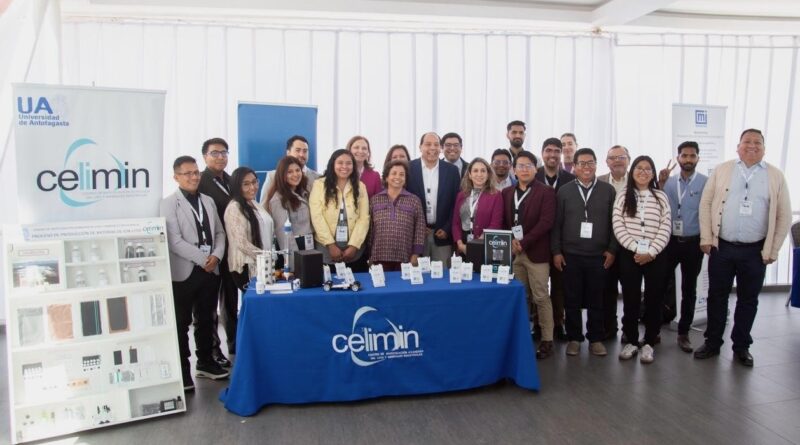CELiMIN marca un hito presentando en IWLiME 2025 las primeras baterías de litio fabricadas en Antofagasta ▶️ CELiMIN marks a milestone by presenting the first lithium batteries manufactured in Antofagasta at IWLiME 2025
IWLiME 2025: primeras baterías de litio fabricadas en Antofagasta marcan un nuevo hito para la industria chilena / IWLiME 2025: First Lithium Batteries Manufactured in Antofagasta Mark a New Era for Chile’s Mining Industry
Durante la 12ª Conferencia Internacional en Minerales Industriales y Energía (IWLiME 2025), celebrada en Antofagasta, el Centro de Investigación Avanzada del Litio y Minerales Industriales (CELiMIN) de la Universidad de Antofagasta presentó las primeras baterías de litio fabricadas en Chile, marcando un punto de inflexión para la ciencia aplicada y la manufactura nacional.
El desarrollo, realizado en colaboración con SQM Litio, representa el paso desde pequeñas celdas tipo botón hacia unidades de base de hasta 7 amp/hora, demostrando la capacidad de la región para generar valor agregado desde la investigación científica.
“Es un hito muy relevante porque demuestra que en las regiones también se puede hacer ciencia de frontera y de alto nivel”, afirmó Mario Grágeda, director del CELiMIN, quien anunció además la construcción de un nuevo edificio de 400 m² destinado a fortalecer la infraestructura científica del centro.
Hito para Chile
El gobernador regional de Antofagasta, Ricardo Díaz, destacó que este logro “marca un punto de inflexión en la historia productiva del norte”, evidenciando que “la región que produce el litio para el mundo también puede fabricar baterías con sello propio”.
Desde el sector privado, Julio García, gerente de Medio Ambiente de SQM Litio, subrayó que la IWLiME “es la principal instancia de diálogo académico sobre innovación en litio” y celebró la alianza con la universidad.
A su vez, Germana González, subgerenta de Asuntos Públicos y Valor Compartido de SQM, enfatizó que “la academia es un actor clave para construir una industria del litio más sostenible y con capital humano avanzado”.
El Instituto Nacional de Litio y Salares (INLiSa) también valoró el avance. Su director ejecutivo, Hernán Cáceres, señaló que “tener baterías de litio fabricadas en la región demuestra que es posible construir una industria basada en ciencia, tecnología y sostenibilidad desde el territorio”.
El evento —que reunió a investigadores, autoridades y empresas— reafirmó que Antofagasta se posiciona como polo de innovación tecnológica para la cadena de valor del litio, avanzando hacia una minería con mayor integración local, innovación y sostenibilidad.
(Por redacción Lithium Triangle South America -News-)
During the 12th International Conference on Industrial Minerals and Energy (IWLiME 2025), held in Antofagasta, the Advanced Lithium and Industrial Minerals Research Center (CELiMIN) at the University of Antofagasta unveiled the first lithium batteries manufactured in Chile — a milestone that underscores the country’s growing scientific and technological capabilities.
Developed in collaboration with SQM Lithium, this breakthrough represents a leap from small coin cells to base units of up to 7 amp-hours, advancing toward regional manufacturing with added value and strengthening Chile’s role in the global lithium supply chain.
“This is a highly significant milestone that reflects years of research and the ability to conduct world-class science from the regions,” said Mario Grágeda, Director of CELiMIN, who also announced the construction of a new 400 m² facility to expand the center’s scientific infrastructure.
Milestone for Chile
Ricardo Díaz, Regional Governor of Antofagasta, emphasized that this achievement “marks a turning point in the productive history of northern Chile,” proving that the region “not only provides lithium to the world but can also create batteries with its own identity.”
From the private sector, Julio García, Environmental Manager at SQM Lithium, described IWLiME as “the main academic forum for lithium innovation,” while Germana González, Deputy Manager of Public Affairs and Shared Value, highlighted the importance of partnerships with local universities to strengthen Chile’s lithium value chain.
According to Hernán Cáceres, Executive Director of the National Institute of Lithium and Salt Flats (INLiSa), this achievement “demonstrates that building a science- and technology-based lithium industry from the region is not only possible but essential for sustainability.”
With growing collaboration between academia, industry, and government, Antofagasta is positioning itself as a technological innovation hub for Chile’s lithium sector, advancing toward a more sustainable and locally integrated mining industry.
(By Editorial Lithium Triangle South America -News-)
Descubre más desde Lithium Triangle South America -News
Suscríbete y recibe las últimas entradas en tu correo electrónico.
